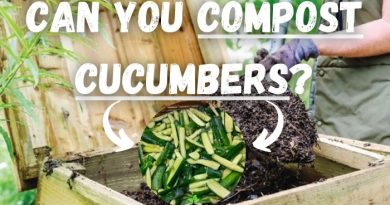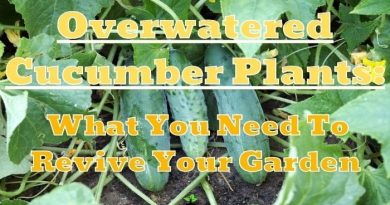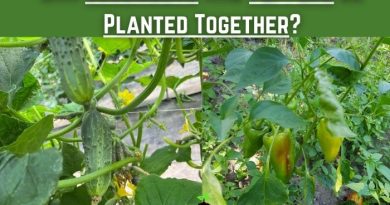Can you Grow Cucumbers from Pickle Seeds? Find Out!
I’ve been gardening for years, and one of the questions I get asked most often is whether you can grow cucumbers from pickle seeds. In this article, we’ll delve into this question and explore whether it’s feasible to use pickle seeds for cultivating cucumber plants.
No, once a cucumber has been pickled, its seeds are no longer viable for growing new cucumbers. The pickling process involves immersing seeds in a solution of vinegar, salt, and other ingredients to create pickled vegetables, which can harm the seeds and render them non-viable for germination. Therefore, it is not recommended to try to grow cucumbers from pickle seeds. However, you can extract seeds from fresh cucumbers that you’ve bought at the store and grow a new crop from them.
However, don’t let that discourage you from growing your own cucumbers! To successfully grow cucumber from pickled seeds, I advise you to opt for fresh, untreated seeds that you acquire from reliable sources. If you wish to save seeds for planting, it’s recommended to carefully choose fully grown, unprocessed cucumbers.
Can you Grow Cucumbers from Pickle Seeds?
Based on my research, I found that it’s better to start with seeds from fresh pickling cucumbers instead of using ones from store-bought jars. These seeds are more likely to produce viable cucumbers because they have not been processed or treated with any chemicals.
It is known that pickling cucumbers often differ from the varieties specifically cultivated for consumption. Consequently, their seeds may not be as suitable, for planting purposes.
So, the success of growing cucumbers from pickle seeds depends on several factors:
- First and foremost, the quality of the pickle seeds plays a role. It’s best to use high-quality seeds that haven’t undergone any processing or chemical treatments.
- Pickling cucumbers are often treated with chemicals and preservatives during the pickling process. These substances can potentially impact both the seed quality and the overall health of the resulting plant. To mitigate this, it is recommended to either choose pickling cucumbers or make sure to thoroughly rinse the seeds before planting them.
- Next, the quality of the soil and its drainage are vital for growing cucumbers from pickle seeds. Cucumbers thrive in draining soil that is rich in organic matter. If the soil is too compact or doesn’t drain properly, it can hinder seed germination and also affect your cucumber’s growth.
- It’s important to note that not all cucumbers meant for pickling are suitable for growing. When cucumbers are picked for pickling, they are usually small and young, which means their seeds may not have fully developed. This can result in poor germination rates and weak plants. To ensure results, it is recommended to use seeds from pickling cucumbers that have had sufficient time to mature on the vine.
- In addition to soil quality, providing sunlight is essential for proper cucumber growth. Plant them in a location to ensure their optimum development.
- Keeping consistent moisture levels is also key for cucumber growth. Regularly water your cucumber to maintain the soil without overwatering them.
- Lastly, cucumbers are prone, to pests and diseases that can harm their growth and yield. Regularly monitoring the plants and taking action at the first sign of trouble is crucial.
Comparison table with differences between cucumber seed types
| Differences in Cucumber Seed Types | Varieties for Pickles | Varieties for Fresh Consumption |
|---|---|---|
| Intended Use | Specifically grown and harvested for pickling purposes. | Typically higher-quality seeds are selected for taste and appearance. |
| Size and Shape | Generally smaller in size and more uniform in shape. | Can vary in size and shape, often larger and more diverse. |
| Seed Quality | May contain seeds with lower germination rates due to processing methods for pickling. | Typically higher-quality seeds selected for taste and appearance. |
| Bitterness | Varieties may have seeds that contribute to bitterness. | Selected for sweeter, milder flavor with fewer bitter compounds. |
| Skin Texture | Thin-skinned varieties are preferred for pickling. | A broader range of skin textures, from thin to thicker, depending on preference. |
| Water Content | May have slightly higher water content due to pickling requirements. | Chosen for balanced water content to ensure crispness and flavor. |
| Plant Characteristics | Bred for compact growth to fit well in jars for pickling. | More diverse growth habits, including vining and bushy types. |
How Do You Get Cucumber Seeds From Pickles
To obtain cucumber seeds from pickles, you can follow these steps:
- Select the right pickle: Not all pickles contain viable seeds, so it is crucial to choose a pickle that has undergone natural fermentation. You can find pickles at health food stores or make your own using a recipe that involves natural fermentation.
- Extract the seeds: Once you have the right pickle, extract the seeds by cutting the pickle lengthwise and scooping them out with a spoon. You can crush the pickle and try to separate the seeds using a sieve.
- Cleanse the seeds: After extracting the seeds, cleanse them by rinsing them under running water and soaking them in a bowl of water for hours. This will help eliminate any remaining traces of pickle juice and debris.
- Dry out the pickle seeds: Once cleaned, spread the seeds on a paper towel and allow them to air dry for a few days. If preferred, you can also use a dehydrator or set your oven to a low temperature to speed up drying.
- Store the seeds: As the last step, it is important to ensure that you store your seeds in a dry location until you are prepared to sow them. You can keep them in a container or an envelope properly labeled with the date and type of seed.
How to Grow Cucumbers from Pickle Seeds
Here’s a detailed step-by-step guide on how to grow cucumbers from pickle seeds:
- Collect Fresh Pickle Seeds: The initial stage of growing cucumbers from pickle seeds involves obtaining fresh seeds from a pickle. It is crucial to choose high-quality seeds that haven’t undergone any processing or chemical treatment. Look for plump firm seeds with color and avoid discolored, shriveled, or damaged ones.
- Prepare the soil: Cucumbers thrive in draining soil enriched with organic matter. Prior to planting loosen the soil to a depth of at least 12 inches and incorporate compost or other organic materials into it.
- Indoor Starting (Optional): To get a head start, consider starting your pickle seeds indoors a few weeks before the last frost. Plant them in seedling trays filled with potting mix. Keep the trays in a warm, well-lit area.
- Plant the seeds: Plant the pickle seeds 1 inch deep and space them around 6 inches apart. If you choose to plant in rows maintain a gap of 3 feet, between each row. After planting make sure to water the seeds.
- Direct Sowing: Alternatively once the threat of frost has passed you have the option to directly sow your pickle seeds into the garden soil.
- Provide support: Cucumbers are vines and need support to grow properly. You can use a trellis, stakes, or a fence to provide support.
- Provide Adequate Water and Sunlight: Cucumbers require consistent moisture to grow properly, so water them regularly to keep the soil moist but not waterlogged. Cucumbers also require full sunlight to grow, so plant them in a sunny location.
- Fertilization: Feed your cucumber plants with a balanced fertilizer every 4-6 weeks to promote healthy growth. Avoid over-fertilizing, as it can lead to excessive foliage growth and fewer fruits.
- Thin the Seedlings: Once the seedlings emerge, thin them to one plant every 12 inches to ensure adequate space for growth.
- Pest and Disease Management: Keep an eye out for pests that affect cucumbers like aphids and cucumber beetles. Utilize pest control methods to protect your plants from these pests effectively. Regularly inspect your plants for any signs of diseases such, as powdery mildew.
To increase your chances of success, it’s best to use fresh, high-quality pickle seeds that have not been processed or treated with chemicals. Start by planting the seeds in well-draining soil, and keep the soil consistently moist.
Can pickled seeds grow?
No, pickled cucumber seeds will not be able to grow into new plants. As an experienced gardener, let me explain why:
When I try to grow plants from pickled cucumber seeds, I’ve found that the pickling process renders the seeds non-viable. You see, pickles are made by soaking fresh cucumbers in a salty brine of vinegar and seasonings.
This acidic, salty environment ends up damaging the seeds over time. I’ve discovered the seed coat becomes very fragile and may even crack open after being pickled.
More importantly, though, the high salt content dehydrates and essentially preserves the seeds in the jar. Without water, a seed simply can’t undergo the natural germination process where it would sprout a new root and stem.
At the end of the day, you need fresh, unpickled cucumber seeds without exposure to vinegar or salt if you want new plants. Only seeds saved from raw, unprocessed fruits can reliably sprout in the garden in my experience.
Conclusion
Typically seeds that have been pickled are not suitable for growing cucumbers. When seeds go through the pickling process they get submerged in a mixture of vinegar, salt and other ingredients to create pickled vegetables. This process can actually harm the seeds. Make them unable to germinate successfully.




